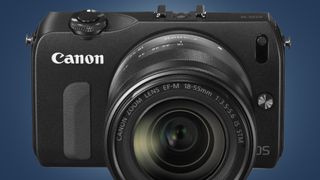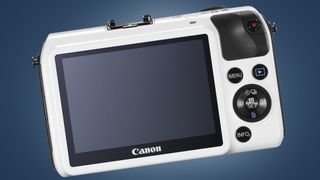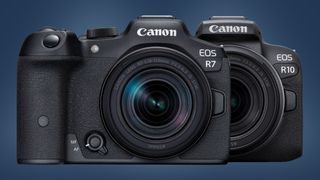The Canon EOS M at 10: a half-baked warning from mirrorless camera history
Opinion: Canon must avoid repeating the EOS M's mistakes

Ten years ago today, Canon launched its first ever mirrorless camera: the Canon EOS M. But the forgotten original won’t be throwing a huge party – instead, it’ll be sipping a Jack Daniels in the corner of a dive bar muttering to the Nikon J1 about what might have been.
The Canon EOS M was never really designed to take over the world. It was a classic defensive move from a tech incumbent, designed to avert photographers' eyes from new mirrorless players like the Sony NEX-7, charming Olympus PEN E-P3 and impressive Samsung NX200.
But what's fascinating about the Canon EOS M is how, almost exactly ten years on, history is seemingly repeating. Across the road from the Canon EOS M's dive bar, the new Canon EOS R7 and EOS R10 – its spiritual successors – are celebrating their two-month birthday in a swanky cocktail parlor.

Those two cameras are different beasts from the EOS M, most obviously because they share the same RF-mount as Canon's full-frame mirrorless cameras. This make sense; rather than separate its hobbyist and pro cameras into incompatible families, Canon is finally following the one-mount strategy of its arch rivals Sony and Nikon. This means its two new players should be among best beginner mirrorless cameras around.
Yet there is one big similarity between the EOS M and Canon's new APS-C mirrorless cameras – a distinct lack of native lenses. Ten years on from the belated arrival of its first mirrorless camera, the camera giant has seemingly killed the whole EF-M family with the EOS R7 and EOS R10. But will those cameras learn from the EOS M's biggest mistake?
Mirrorless gatecrasher
The Canon EOS M was born into a very different world to the EOS R7 and EOS R10. In July 2012, Facebook had only just started its plan to destroy Instagram after buying it for $1bn and the most popular smartphone around was the Samsung Galaxy S3, which had a single 8MP camera.
If Canon understandably didn't see smartphones as a threat back then, it was a bit too dismissive of mirrorless cameras. The first of those, the Panasonic Lumix G1, landed a full four years before the EOS M in 2008, and Canon's mirrorless debut felt like a reluctant, toe-dipping experiment from the DSLR giant.
Get daily insight, inspiration and deals in your inbox
Get the hottest deals available in your inbox plus news, reviews, opinion, analysis and more from the TechRadar team.
Not that the EOS M was without its charms. It had a large 18MP APS-C CMOS sensor, the same as the one in the Canon EOS 650D DSLR that arrived a month before it. Yet it was also impressively small, not dissimilar in size to a Canon PowerShot compact camera, and came in four colors including (gasp) red and white.

Something else that the EOS M got very right was its touchscreen. It's taken cameras agonizingly long to embrace touchscreens, particularly ones that work with their menus, but the EOS M did it back in 2012 with a responsive panel that put many later cameras to shame.
Unfortunately, the EOS M also fell down in two big areas. One of these, sluggish autofocus, was somewhat understandable for the time, and would later be greatly improved by successors like the Canon EOS M6 Mark II.
But the other, a lack of native lenses, would remain the bane of the series until, well, their apparent recent death with the arrival of the Canon EOS R7 and EOS R10 in May this year. The question is, does Canon care enough about APS-C mirrorless cameras this time to avoid the same mistake?
Glass half full
When it came to making hobbyist-friendly mirrorless cameras in the early 2010s, the big incumbents – Canon and Nikon – were always in a difficult spot when it came to lenses.
They had already made huge ranges of lenses for their DSLR cameras. So their three options were; ignore mirrorless cameras completely (which they tried for a while), leave DSLRs behind and go all-in on mirrorless (not really feasible at the time), or take a non-committal halfway house by making a lens adapter that connected their old lenses with their new mirrorless cameras.
Like Nikon, Canon took the latter route. Its EF-EOS M adapter meant EOS M owners had, in theory, access to over 60 DSLR lenses. Yet most of these weren't a good fit for compact mirrorless camera (or 'CSC' as they were known then). And it meant Canon could afford to be somewhat lazy with the introduction of proper native glass that could have elevated the EOS M, and its successors, to exciting mirrorless heights.

In the ten years after the EOS M's arrival, Canon made just eight lenses for the camera and its successors. Most of these, bar outliers like the EF-M 32mm f/1.4 STM, were pretty dull, plastic affairs. Sigma and Tamron later came in to fill the considerable gaps, but by that point Canon had already moved onto its new mirrorless plaything: the RF mount.
For all of its good points, the Canon EOS M (tagline "be a playfessional") was the embodiment of its maker's feelings about hobbyist mirrorless cameras – it just didn't take them seriously. Whether it was AF performance, video crops or lenses, there was always a sense that an EOS M camera would be hobbled in some way. Despite the arrival of some solid successors like the Canon EOS M6 Mark II, that remained the case for the next decade.
History repeating?
Not that the Canon EOS M and the mirrorless family it started can be considered a failure. They've always been popular in Japan, where even as recently as this year the Canon EOS M50 and M50 Mark II have been among the top-selling cameras (according to BCN Retail).
Yet the Japanese camera market is quite different from the rest of the world and Canon hasn't released a new EOS M body since the 2020. The lack of investment in the system has been clear and the arrival of the EOS R7 and EOS R10 show that it's curtains for a system that started exactly a decade ago today.

But will these two cameras suffer the same fate as the original EOS M? This time around, the signs are much more positive. Both the EOS R7 and EOS R10 have similar Dual Pixel CMOS AF II autofocus smarts to much pricier cameras like the Canon EOS R3, which lets them track subjects including animals and vehicles. This is particularly impressive for the EOS R10, which costs only $979 / £899 / AU$1,499.
The two cameras also have the big benefit of being compatible with all of Canon's latest full-frame mirrorless glass, thanks to that RF-mount. That's a much better solution than the EOS M's adapter-based approach.
Yet that doesn't mean that APS-C mirrorless cameras don't need their own native glass. A big reason for buying a camera like the EOS R7 or EOS R10 is because the lenses, and the whole setup, can be smaller, lighter and cheaper than their full-frame equivalents.
Right now, there are only two 'RF-S' lenses for the EOS M's two spiritual successors (an 18-150mm and 18-45mm). Sound familiar? Yes, you can still adapt some lovely older glass with the EF-EOS R adapter, but let's hope Canon has a few more native lenses in the pipeline than the eight it gave the poor old EOS M series.

Mark is TechRadar's Senior news editor. Having worked in tech journalism for a ludicrous 17 years, Mark is now attempting to break the world record for the number of camera bags hoarded by one person. He was previously Cameras Editor at both TechRadar and Trusted Reviews, Acting editor on Stuff.tv, as well as Features editor and Reviews editor on Stuff magazine. As a freelancer, he's contributed to titles including The Sunday Times, FourFourTwo and Arena. And in a former life, he also won The Daily Telegraph's Young Sportswriter of the Year. But that was before he discovered the strange joys of getting up at 4am for a photo shoot in London's Square Mile.
